For British teenagers in the 1980s, the delights of 8-bit computers such as the Sinclair Spectrum, Commodore 64, or BBC Micro were firmly restricted to the offline arena. We would read about the BBS scene on the other side of the Atlantic, but without cheap local calls and with a modem costing a small fortune, the chances of us ever experiencing one was zero. When we took the British school rite of passage of a trip to France though, we were astounded to see that every French person was not merely online, but that they were doing so with a neat little all-in-one terminal. We’d just been introduced to the French Minitel system, and in that minute shared a glimpse of the future.
Un Réseau Trés Français
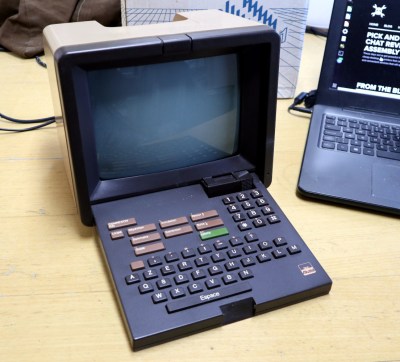
In the 1970s and 1980s, so-called videotext systems, terminal-based phoneline access to information services on central computers, were seen as an obvious next step for telephone network operators with an interest in profitable new products. In most countries this resulted in services such as the UK’s Prestel, a subscription service relying on costly hardware, but France Télécom instead pursued the bold path of making the terminals free to subscribers with free access to phone listings and yellow pages, but a business model based on pay-to-use premium services.
Thus, through the 1980s all French households had a Minitel terminal beside the phone, and the service became a runaway success. Ever since seeing Minitel terminals as a tourist I’d been fascinated by the service, so here in the 2020s when a friend was visiting their family in France I asked whether he could pick up an old Minitel terminal for me. Thus I found myself parting with around $25 and being rewarded with a slightly battered Minitel cardboard box containing one of the familiar brown Alcatel terminals. I certainly wasn’t expecting one in its original packaging.
On the desk in front of me, it resembles a small CRT TV set, roughly 250 mm x 220 mm x 260 mm. The 9″ monochrome screen is covered by the keyboard, which is released by pressing a button at the top and hinges down in front of the screen. At the back of the unit on one side is a French telephone socket for the conventional phone and mains and phone wall socket cables, while on the other side is a DIN socket for a serial port. The keyboard feels very solid indeed, with a clicky AZERTY layout as well as a numerical pad and a series of call function keys. FInally there’s a power button and a display brightness slider, and when the unit is powered up the letters typed appear on the screen.
Clever Design Makes It A Joy To Dismantle 37 Years Later
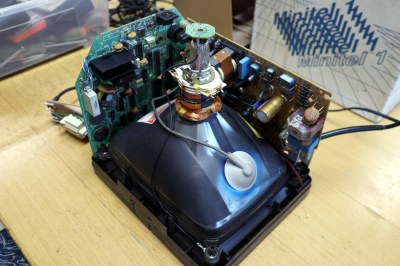
Examining the rear before dismantling the device, it’s clear that there are no screws, instead everything is held together by plastic clips. This makes careful removal of the rear case a straightforward process, revealing the internals. There are two interlocking PCBs, one containing the power supply and the monitor electronics below the tube neck, and the other containing the terminal electronics up the left hand side. A flat flexible cable connects this to the keyboard. Leaving the monitor PCB in place it’s very straightforward indeed to unplug the terminal board for a closer look.
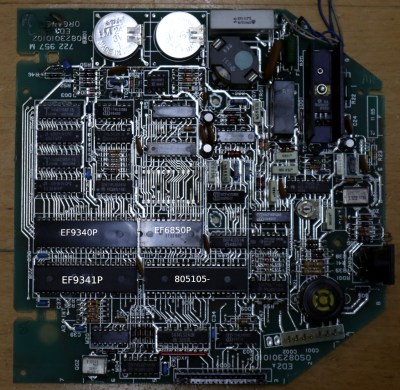
It’s possible to make a serial terminal without any microprocessor in sight, however many later terminals use an 8-bit micro to replace a lot of logic and lend some basic smarts. In this case it’s an 8051, paired with a 6850 UART for serial communication and the Thomson EF9340 and EF9341 video graphics chipset. These last two chips are an interesting pair, with their own 16-bit data bus requiring 1 K x 16 RAM, and while I’m not sure whether they were specifically designed for Minitel it’s clear that their strengths like more in videotext than in home computers.
All the chips in this unit have date codes from spring 1985, so it likely first saw service later that year. It’s worth noting that an online search reveals versions of this terminal with an entirely different mainboard featuring a different processor and an expansion bus, evidently since the device never ran any user software its internals did not make any difference for the service. The keyboard clips apart to free it from its hinge, revealing a very substantial metal frame surrounding its PCB. This particular terminal has a problem with some of its keys, soon revealed to be due to a failing keyboard cable. I see a couple of adapter PCBs and a more robust modern flat cable in my future.
What Do You Do With An ’80s Dream Here In 2022?
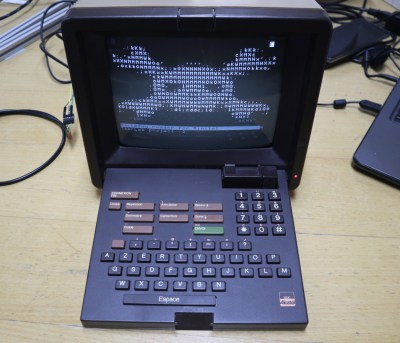
Given the mild annoyance of having to fix my keyboard cable, what can I do with a Minitel terminal here in 2022? The original France Télécom system was shuttered back in 2012, so it’s hardly as though I can dial up to any official services. Fortunately there still exists a lively Minitel hacker scene who program and operate their own services both via the phone for a traditional terminal as online in a web browser. For the minor effort of building a serial cable for that DIN socket I can talk to my terminal from a computer, and among many other options I can use a Python library or an Arduino library to do whatever I want with it. If I can’t be bothered to do any work on it myself, there’s even a Hackaday reader written for me by a friend in a Dutch hackerspace.
With my Minitel terminal carefully reassembled and awaiting such time as I can fix its keyboard cable, I’m sure I’ll find a fun use for it among the plenty of options.
It’s worth signing off with a reminder for anyone tempted to get a Minitel terminal of their own. These terminals were given for free to every French telephone subscriber, and at the height of its popularity every household in France had one. My friend tells me that while a few of the many Minitel models are rare and sought-after, the run-of-the-mill ones like mine are still plentiful enough that any vendor who reads this article and imagines a price hike can be told to take a hike. Find a French friend as I did, and see if they can help you find one.

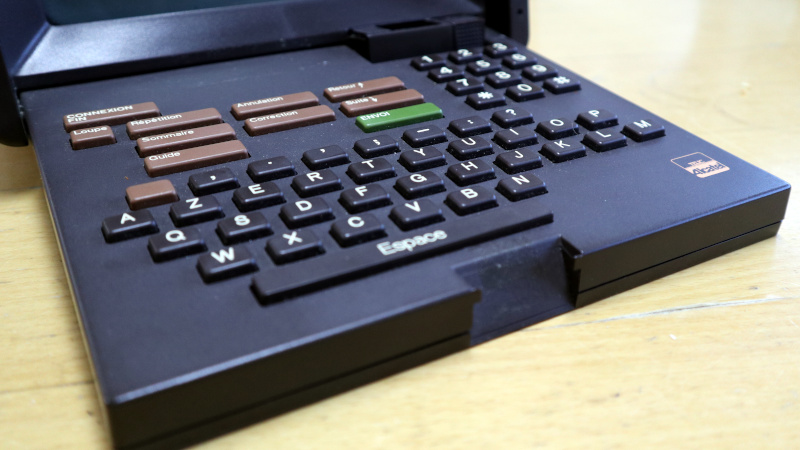













The lack of free local calls in the UK is one of my historical laments, it set us back in the modern world somewhat – we would have had our own home grown versions of the big online services (and kept more of our own money) if only someone had had the foresight to bring in unmetered local calls to dedicated computing services.
Same in Germany. The prices got jacked up when the Telekom got split up and privatized from the Bundespost in the 90s and it took us several lost years from the first home user internet in 1994 to a feasable and payable flatrate in 1998. -.-
This thing cost so much money to my parents… O.o
3615 ulla
haha 3617 way more expensive than 3615 (price of local call)
3615 was 0.73 Francs every 6 minutes IIRC, seems cheap but piled up quite quickly!
I can hear that commercial.
If I recall correct, did those terminals 1200/75 baud.
1200bd for information from the server, 75bd for information to server (key strokes).
That nifty design choise on bandwidth might be reason that it was replicated in ADSL, with the A from Asymmetric.
According to Wikipedia, minitel used ITU V.23 for communication over the telephone lines.
Quoting https://en.wikipedia.org/wiki/Minitel#Technology
Minitel used a half-duplex asymmetric data transmission via its modem. It downlinked at 1200 bit/s (9 KB/min) and uplinked at 75 bit/s (0.6 KB/min). This allowed fast downloads, for the time. The system, which came to be known as “1275” was more correctly known as V.23. This system had been developed for general-purpose data communications, but was most commonly used for Minitel and equivalent services around the world.
@MrSVCD: thanks for confirming the IIRC
I even used it to download Amstrad CPC programs in the 90’s. There was an interface cable to link the Amstrad to the minitel, then a server allowed to freely download games.
I think they get paid by the cost of the communication which was a lot !
When my parents received the phone bill I realized it wasn’t “free download” …
It would be interesting to see what’s in the other version with the expansion port. Is there a schematic somewhere or a model number?
Well, I quickly made a Minitel emulator software on my PC, using the Minitel as a modem.
Then I could automatize the connection to kinky Minitel chat sites and find a girlfriend ;-)
Early social networking
Here in Canada, the phone company (a monopoly back then) had a Minitel-like service called Alex. Memory.says it started in 1988 or 89, and I don’t think it got beyond a rollout in 2 or3 major cities. There were small, presumably “cheap” terminals, I don’t remember if they were rented or handed out. At some point the company offered software so you coukd use your own comouter, as long as it was an “IBM PC” or maybe a Mac too. I don’t know what the plan was, it seemed to be about online services rather than phonebook replacement. But I don’t think much got online, I don’t recall much of interest. And before it spread much, it was shut down.
I know in the fall of 1996 there were surplus terminals, so I think it was over by then, thiugh perhaps not quite ended. The local freenet, “access for all”, had a supply of the terminals to get peoole online. So those could be used as ascii terminals, the freenet only providing a limited shell access, no ppp. I saw one at a fleamarket around that time, but never since.
I remember those, they cost a fortune if I remember. Here’s stuff from the Wikipedia article.
“The Alextel terminal was based on the French Minitel terminals, built by Northern Telecom and leased to customers for $7.95/month. It consisted of a CRT display, attached keyboard, and a 1200 bit/s modem for use on regular phone lines.[4] In 1991 proprietary software was released for IBM PCs that allowed computer users to access the network. Communications on the Alex network was via DATAPAC X.25 protocol.[5]”
“The Alextel terminal is reportedly usable as a dumb terminal for VT100 emulation.[4]”
I suppose you could hook it to the internet with a Pi.
Would be nice to get one’s hands on one, being as they’re QUERTY.
I was there with my Atari 400 at 300 baud, I had a modified BBS program that supported 2 modems on 2 distinct phone lines, I implemented one on one chatting and 2 players online games, the good old early 80 days…
I remember connecting my CPC 464 to my parent’s Minitel to download “games” and record them to a tape. Looking it up, it seems I had to have bought a connection kit for it. I think I was about 10 years old.
I remember this kit which plugged from the Minitel DIN to the joystick port of the Amstrad and I remember I downloaded the “Ghostbusters” game for my Amstrad CPC6128, it took something like 30-45 minutes to download and communication was pretty expensive, better buy games on disks in the end ;)
I’ve never seen a broken one. Some had keyboards failures, but not booting was not an option. Amazing time of life. If i need a nas, this will be the enclosure!
Thanks for this great teardown! Hackaday reader app seems really cool too, I will try it for sure :)
May be interesting for some reader: there is an application named socketel that makes possible to browse minitel “web-services” on a real minitel using an ESP32
Très (typo on the ‘è’ of “Très” in the title).
These terminals are so fun, I got one a few when I was living in Germany
https://i.imgur.com/UvczV0N.jpg
My first connection to the Internet was via 3615 INTERNET, a minitel gateway to the internet setuped by Valentin Lacambre:
https://fr.wikipedia.org/wiki/Valentin_Lacambre
Part of my familly was french, so on Sunday afternoons we would be in front of the Minitel.
I still have my old Minitel 1B in the attic. This is the one with the improved 80 character display.
Back in the early 90’s I had hacked the IR port of my HP28S calculator into a serial port, connected to the serial port of my minitel.
That allowed my to record minitel pages into my HP28S and play them back later-on. Since it was billed by the second and not cheap for a software engineering student like me.
I still have my HP28S and its custom-made hardware interface to the minitel and work for the company that invented it, in the city where it was made.
As a French, the Minitels are effectively really easy to find and buy on auction sites, if you happen to come here. However, I remember that a lot of them were destroyed or thrown away by FT when they shut down the services. I plan to buy one to use it to SSH to different servers, but I’m afraid it would be too slow to be actually convenient enough to use.
Very useful to communicate with an old board (6502,6809,Z80,…) at 4800 bauds (fixed speed of the serial connector). You have just to remember the weird sequence of keys to put your minitel on this mode :-)
Good old times…
I remember dialup modems getting callbacks from corporate systems, then using a dialout to get free phone lines to call all BBS and Minitel systems in the world. Until the cops showed up at the door…
I believe this is a bold overstatement according to Wikipedia “by 1988 three million terminals were installed” which is a lot but not nearly one per household.
I so wanted a Sinclair. I was in Tafe college at the time, learning computing and another student had one. I ended up with a commodore. At work we used a Tandy trs80 to test relay boards on the new digital telephone exchange. This was the start oh the 80s.
Not everybody had these, I grew up having no Minitel home (I was an 80’s kid), and got my first one salvaged from the dumpster at work.
Very good analysis, unless you missed some details:
-Yours is a Minitel1 “retournable”, so the modem can be reversed as a server-side one, so two machines can communicate directly (while I don’t know the local key combination to perform this on these models).
-Also, it has a very small amount of low power battery-backed SRAM (4kb), this was ripped off next models, as froggies are quite sensitive with privacy and reading its content wasn’t possible on the user’s side (only via a distant server request).
-The mainboard is the same as in the Matra’s retournable model, but the whole design of the Alcatel one is far better, with a far superior keyboard (Matra’s ones seem mushy, foam loaded keys, while far quieter, this is true for the M1b as well (Shared MB and crappy keyboard), the Matra M5 portable fortunately got a higher standard one).
-The unpopulated chip can be an EPROM, so if you ground the 8051’s /EA pin, you can have it run your own program.
The EFCIS EF 934x series were terminal/videotext-oriented CRT Video Display Generators, with interesting customizable character-based graphics that allow “tile” graphics from the EF9345, that equipped not only the Minitel 1b (bistandard), but also two initiation machines: The Philips/Radiola/Schneider VG5000µ (along with a Z80), and the Matra/Hachette Alice 32/90 (not the 4k TRS80 MC-10 clone!) (along with a MC6803).
While the services may keep backward compatible with the earlier machines, every terminal “update” followed the specs’, so that they got “shortcuts” to lower the loading times, 80 column mode, customizable characters, and “graphics possibilities” over time. That’s why they came from Intel i8039/EF9340 (ABC keyboard…) up to intel i8052/EF9347 and over. The remote server can ask the machine what it is (manufacturer and spec version supported), so it can adapt what version of the code it sends.
As the keyboard connector pitch is standard, you can easily replace it with ribbon cable, the tricky part may be the reconnection to the inner membrane, if the keyboard is not on a PCB.
You can still reach “microservers” (see https://fr.wikipedia.org/wiki/Micro-serveur_Minitel#Liste_de_Micro-serveurs ), even through your set-top box’s VoIP line, but you also need a phone plugged into the back of the machine (or piggybacked on its wall plug, depends on the model), to dial the number first, unless you have a Minitel 2 or former model, or an all-in one phone and Minitel 10 or 12.
You can also communicate from Minitel to Minitel with a friend who is skilled enough to set up his side of the rig, unless you find how to reverse your’s modem (I did it couple years ago to validate the hypothesis that such a communication could be set up).
You should not accept to buy these for too much, I personnally never had to fork any coin for these, they were donated or traded. I salvaged some to study then passed on to friends when no interest for my project, or lack of storage space.
I was lucky enough that the first Minitel (Alcatel M1b) that came to me was the i8032/EF9345 with its “expansion bus” populated by a ROM daughtercard, and the second I soon had was the exact same, but with an i8052 and no daughtercard, so I could compare both. I reverse engineered the whole, and traced every 32 pins, but got stuck for 5 years because I never got the 8032 to work with any EPROM, even back with the genuine, so I could test code. I wanted to design a daughtercard with ram partially backed up, and adressable in both Code and Data areas, with expansion bus (parallel chip), RTC, but wanted to know what are the three additionnal pins in the M2 to take them into account from the beginning.
See where I begun: https://forum.system-cfg.com/viewtopic.php?f=5&t=5470
You’ll find links to what JeffHXC did, he had the idea before me to do the same on the RTIC M2 model, on which he did a demo, you’ll find on YT, its expansion connector is where the EPROM sits, with some more slots over.
RÖB>
Go for the Minitel 1 bistandard (either Matra or Alcatel), or Alcatel M2, they have arrows, shift and Ctrl keys that earlier models don’t have.
Garrut>
I’ve seen some with issues on the CRT side (one stuck to pre-heat and the other one with permanent beam)
Michel>
There was 300, 1200, 2400 and 4800 Bauds, plus 9600 on the M2s.
videotext → videotex; their → his; , however → ; however; like → lie; their → one’s; they → one, who
How did you get it to work since it doesn’t have a FCTN key?